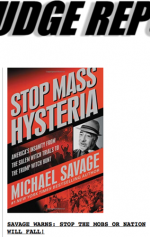October 12, 2018
Michael Savage's Account of Political Madness Then & Now: Stop the Mass Hysteria
By Thomas Lifson
A
https://www.americanthinker.com/art...ess_then__now_emstop_the_mass_hysteriaem.html
Stop the Mass Hysteria: America's Insanity from the Salem Witch Trials to the Trump Witch Hunt
Center Street/Hachette Book Group
305 pages, plus 30 pages of footnotes and index
Michael Savage's timing could not be better in publishing his new book, Stop the Mass Hysteria: America's Insanity from the Salem Witch Trials to the Trump Witch Hunt. Trump Derangement Syndrome has driven a large chunk of the media and tens of millions of Americans barmy, and they are acting out -- and alarming the rest of us. The very day after the book was published, Eric Holder was caught on video calling for the "new Democratic Party" to "kick" opponents when they "go low," whipping the crowd to which he spoke into laughter and applause.
Matt Drudge caught the synchronicity and featured the book's warning at the top of his page on October 11, 2018:
Savage employs a broad definition of mass hysteria, characterizing two complementary aspects of it on page 35:
Under this broad charter, he roams through our history with a series of highly entertaining essays on incidents of mass hysteria – some famous, but others relatively obscure. He ranges from the Puritans right up to the present with his explanations of outbreaks of mass hysteria. Not all of the stories he delves into have stereotypically conservative heroes – for instance, his discussion of the mob psychology in pre-revolutionary Boston, during what they called at the time the "bloody massacre" and what we call "the Boston Massacre." The patriots, a label of which Savage is fond, were the ones getting hysterical and disregarding facts, and it required the skillful defense of John Adams to overcome the hysteria of the moment and see the British soldiers acquitted of murder.
Savage deftly weaves in observations on the impact of technology on mass hysteria, making the case that modern media, especially social media, are exacerbating the problems. He observes that the first form of social media, gossip in a village, could rapidly spread in a confined area. But the present-day landscape of social media, cable news, and mobile devices brings immediacy and involvement on a scale unimagined in human history.
At his best on his talk show, The Savage Nation, he can be a master storyteller, and that voice is heavily present in this book. Many of the essays are full of interesting angles, and, as he does on air, Savage ranges widely in bringing in comparisons or taking a moment to dwell on a related matters.
This was a fun book to read, or, as academics like to say, it is "accessible." While covering a lot of historical ground and well documented in footnotes, it is also an involving set of tales, told by an identifiable and engaging voice.
My absolute favorite among the essays was the second half of Chapter 11, "From Commies to Comics." After discussing the Hollywood Blacklist and Joseph McCarthy in a nuanced fashion that conveys the genuineness of the threat but follows the thread of hysteria that eventually was used to discredit anti-communism, he turns to an entirely unexpected comparison: the anti-comic book hysteria of the 1950s, in which lurid comic books were claimed to be corrupting the nation's youth, leading to congressional hearings. The hero of this particular tale is a man named William Gaines, with whom Savage explicitly states he identifies.
Gaines came home from World War II and joined, and eventually took over, the business started by his father, Max Gaines, whom Savage dubs "one of the most important men in the history of popular culture." Gaines, you see, invented the comic book, because as a printer, he was bothered that the special presses used to print Sunday color comics sections for newspapers sat idle most of the week. He first reprinted Sunday comic strips in book form, stapled together, and then moved on to original content. When Max Gaines died in a boating accident in 1947, son William took over the business. Among his titles was Tales from the Crypt.
Following publication of a best-selling book by a psychologist, Seduction of the Innocent, Senator Estes Kefauver scheduled hearings of his Senate Subcommittee on Juvenile Delinquency and dragged Gaines before it and harangued him. Kefauver went on to greater prominence, snagging the vice presidential nomination of the Democrats in 1956, with Adlai Stevenson at the top of the ticket. They lost, while Gaines lost everything. The backlash against comics drove him out of business.
Now, it turns out that there is a happy ending to this story, but I refuse to ruin it. If that's a reason to go out and buy the book, you probably won't mind if you've read this far.
Michael Savage's Account of Political Madness Then & Now: Stop the Mass Hysteria
By Thomas Lifson
A
https://www.americanthinker.com/art...ess_then__now_emstop_the_mass_hysteriaem.html
Stop the Mass Hysteria: America's Insanity from the Salem Witch Trials to the Trump Witch Hunt
Center Street/Hachette Book Group
305 pages, plus 30 pages of footnotes and index
Michael Savage's timing could not be better in publishing his new book, Stop the Mass Hysteria: America's Insanity from the Salem Witch Trials to the Trump Witch Hunt. Trump Derangement Syndrome has driven a large chunk of the media and tens of millions of Americans barmy, and they are acting out -- and alarming the rest of us. The very day after the book was published, Eric Holder was caught on video calling for the "new Democratic Party" to "kick" opponents when they "go low," whipping the crowd to which he spoke into laughter and applause.
Matt Drudge caught the synchronicity and featured the book's warning at the top of his page on October 11, 2018:
Savage employs a broad definition of mass hysteria, characterizing two complementary aspects of it on page 35:
Mass Hysteria – or mass hypnosis – is insidious and stealthy. It falls into two categories. The first is "positive hallucinations or hysteria," when you believe something is real, absent evidence, just because someone says so or it fits your preconceived notions. The second is "negative hallucinations or hysteria," when you deny the existence of something real, despite overwhelming evidence that it exists.
Under this broad charter, he roams through our history with a series of highly entertaining essays on incidents of mass hysteria – some famous, but others relatively obscure. He ranges from the Puritans right up to the present with his explanations of outbreaks of mass hysteria. Not all of the stories he delves into have stereotypically conservative heroes – for instance, his discussion of the mob psychology in pre-revolutionary Boston, during what they called at the time the "bloody massacre" and what we call "the Boston Massacre." The patriots, a label of which Savage is fond, were the ones getting hysterical and disregarding facts, and it required the skillful defense of John Adams to overcome the hysteria of the moment and see the British soldiers acquitted of murder.
Savage deftly weaves in observations on the impact of technology on mass hysteria, making the case that modern media, especially social media, are exacerbating the problems. He observes that the first form of social media, gossip in a village, could rapidly spread in a confined area. But the present-day landscape of social media, cable news, and mobile devices brings immediacy and involvement on a scale unimagined in human history.
At his best on his talk show, The Savage Nation, he can be a master storyteller, and that voice is heavily present in this book. Many of the essays are full of interesting angles, and, as he does on air, Savage ranges widely in bringing in comparisons or taking a moment to dwell on a related matters.
This was a fun book to read, or, as academics like to say, it is "accessible." While covering a lot of historical ground and well documented in footnotes, it is also an involving set of tales, told by an identifiable and engaging voice.
My absolute favorite among the essays was the second half of Chapter 11, "From Commies to Comics." After discussing the Hollywood Blacklist and Joseph McCarthy in a nuanced fashion that conveys the genuineness of the threat but follows the thread of hysteria that eventually was used to discredit anti-communism, he turns to an entirely unexpected comparison: the anti-comic book hysteria of the 1950s, in which lurid comic books were claimed to be corrupting the nation's youth, leading to congressional hearings. The hero of this particular tale is a man named William Gaines, with whom Savage explicitly states he identifies.
Gaines came home from World War II and joined, and eventually took over, the business started by his father, Max Gaines, whom Savage dubs "one of the most important men in the history of popular culture." Gaines, you see, invented the comic book, because as a printer, he was bothered that the special presses used to print Sunday color comics sections for newspapers sat idle most of the week. He first reprinted Sunday comic strips in book form, stapled together, and then moved on to original content. When Max Gaines died in a boating accident in 1947, son William took over the business. Among his titles was Tales from the Crypt.
Following publication of a best-selling book by a psychologist, Seduction of the Innocent, Senator Estes Kefauver scheduled hearings of his Senate Subcommittee on Juvenile Delinquency and dragged Gaines before it and harangued him. Kefauver went on to greater prominence, snagging the vice presidential nomination of the Democrats in 1956, with Adlai Stevenson at the top of the ticket. They lost, while Gaines lost everything. The backlash against comics drove him out of business.
Now, it turns out that there is a happy ending to this story, but I refuse to ruin it. If that's a reason to go out and buy the book, you probably won't mind if you've read this far.


